Your wearable’s voice assistant drains battery because it’s constantly listening for wake words, keeping microphones and processors active instead of letting your device enter deep sleep mode. This always-on listening consumes 5-10% of your battery daily even without interactions, while active voice commands drain another 1-5% per query. The continuous audio processing, cloud data transmission, and AI computations create a perfect storm of power consumption that can reduce your smartwatch’s battery life by up to 40% overnight. Understanding these underlying mechanisms reveals practical solutions you can implement today.
The Hidden Power Consumption of Always-On Listening
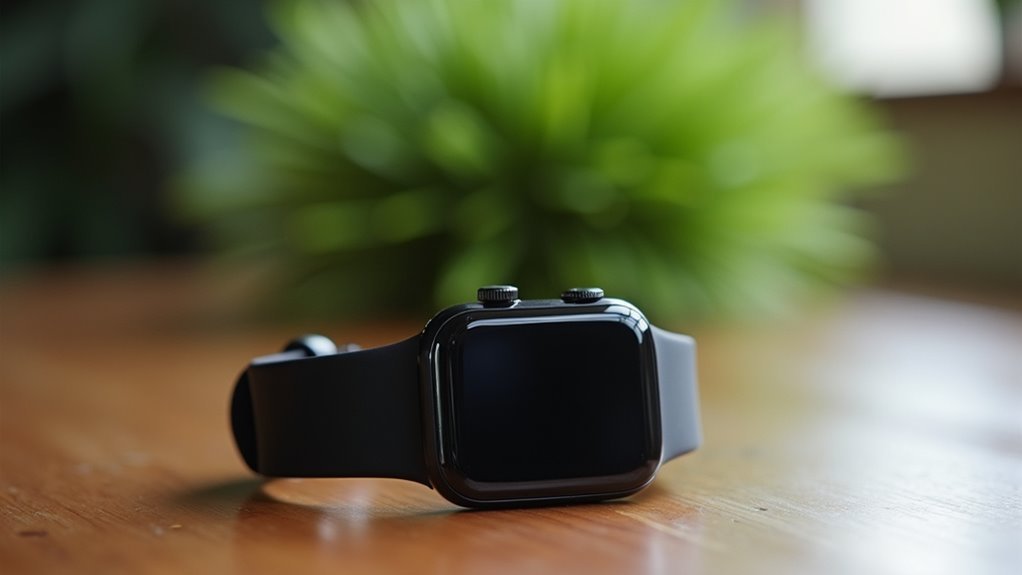
While your voice assistant appears to be sleeping, it’s actually working around the clock, quietly draining your device’s battery. The continuous listening feature requires constant power to keep microphones and processing units active, preventing your wearable from entering deep sleep modes that would conserve energy.
Your device’s microphone alone consumes significant power staying alert for wake words. This perpetual state of readiness competes with other essential features like heart rate monitoring and wireless connectivity for your limited battery resources.
The industry targets keeping this consumption below 1 milliamp, but even this seemingly small draw accumulates quickly. Advanced solutions can reduce power consumption to just 9 microwatts using specialized hardware implementations.
You’ll notice this impact most on wearables, where consumers expect multi-day battery life but always-on listening can dramatically reduce operational time between charges.
Data Processing Demands That Overwhelm Wearable Hardware
When you activate your wearable’s voice assistant, you’re demanding it process massive amounts of audio data that would challenge even larger devices.
Your smartwatch or fitness tracker must decode complex speech patterns, compress audio files, and run memory-intensive algorithms—all while operating with severely limited RAM and processing power.
This mismatch between what voice recognition requires and what your tiny device can actually handle creates an enormous drain on your battery. The continuous monitoring of voice commands significantly amplifies these energy demands, making the problem even worse for battery longevity.
Large Volume Data Processing
As your smartwatch processes voice commands, it’s handling an enormous amount of data that can quickly overwhelm its compact hardware. Every word you speak requires complex analysis through advanced AI algorithms and natural language processing models.
When you use multilingual features, your device must juggle multiple language models simultaneously, multiplying the computational load.
Your wearable continuously senses audio inputs, maintaining constant readiness to respond. This real-time processing demand keeps components like microphones, processors, and memory working overtime.
The sophisticated machine learning models needed for accurate speech recognition consume substantial computational resources, while data transmission to cloud servers adds another layer of power consumption. Modern wearables have evolved from basic trackers to comprehensive systems that demand significantly more processing power.
These intensive processing requirements create inefficient power consumption patterns that directly impact your device’s battery longevity.
Hardware Memory Processing Constraints
Your smartwatch’s limited hardware creates a significant bottleneck when processing voice assistant demands. Your device’s memory constraints prevent efficient storage and processing of large AI datasets, forcing continuous data exchanges that drain battery life.
| Processing Challenge | Impact on Memory | Battery Drain Effect |
|---|---|---|
| AI-Driven Features | High RAM usage for neural networks | Severe power consumption |
| Continuous Listening | Constant buffer allocation | Moderate ongoing drain |
| Noise Cancellation | Real-time audio processing | High computational load |
| Multi-Modal Interactions | Multiple data streams | Exponential power usage |
| Software Updates | Temporary storage needs | Periodic heavy drain |
Your wearable’s low-power processors can’t handle voice assistant tasks efficiently, creating processing bottlenecks. Always-on sensors and background processes compound the problem, while outdated hardware struggles with real-time processing demands, ultimately overwhelming your device’s limited capabilities. The technical debt accumulated in voice assistant software further exacerbates these hardware limitations, as bloated code requires more processing power than your wearable can efficiently provide.
Network Connectivity Requirements for Voice Recognition
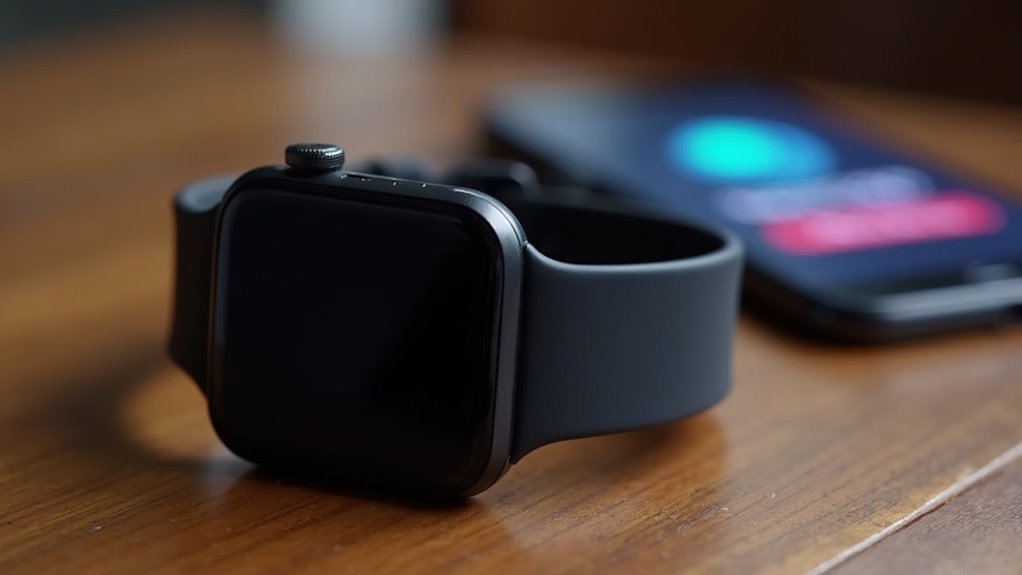
Your wearable’s voice assistant can’t function without constantly sending data to cloud servers, and this network activity becomes one of the biggest battery drains on your device.
Every voice command you speak must travel over Wi-Fi, Bluetooth, or cellular networks to reach remote processing centers, then the response gets transmitted back to your wrist. WorkManager is recommended for handling these asynchronous voice data requests efficiently.
These round-trip data transmissions consume significant power, especially when your device maintains persistent connections to guarantee the voice assistant responds quickly to your commands.
Data Transmission Power Costs
When your voice assistant wearable streams audio data to cloud servers, the continuous wireless communication creates one of the largest drains on your device’s battery.
Your device’s radio consumption spikes considerably during Wi-Fi or cellular transmissions, while even Bluetooth Low Energy requires frequent activations that steadily drain power.
You’ll notice your battery depletes faster when environmental noise forces data retransmissions or extends transmission periods.
The protocol you’re using matters greatly—frequent small voice packets waste more energy than bulk transfers due to header overheads and radio state changes.
Your device also sends pre-roll audio buffers before wake word detection, prolonging active transmission time and amplifying power costs through extended radio usage periods.
Areas with unstable connections compound this problem, as your device maintains continuous listening mode to compensate for connectivity issues.
Cloud Processing Dependencies
While local processing handles basic wake word detection, voice assistants depend heavily on cloud servers to perform complex speech recognition and natural language understanding tasks.
Your device must maintain stable internet connectivity throughout each interaction, creating continuous network activity that drains your battery faster than offline operations.
When you speak commands, your wearable transmits encrypted audio data to remote servers for processing.
Poor network conditions force your device to retry transmissions, amplifying power consumption. The constant need for adequate bandwidth strains your device’s radio components, while high latency situations require extended connection times. Optimal voice transmission requires latency below 150ms to prevent excessive battery drain from prolonged connection attempts.
Cloud dependency means your voice assistant can’t function without reliable connectivity, making your wearable work harder to maintain these essential network connections and greatly impacting battery life.
Background Operations Running Behind the Scenes
Although voice assistants appear dormant when you’re not actively speaking to them, they’re constantly performing numerous background operations that steadily drain your device’s battery. Your device’s microphones remain perpetually active, listening for wake words while processing ambient noise to optimize voice recognition. This continuous audio signal processing requires consistent power consumption.
Your voice assistant also maintains network connectivity for cloud services, periodically downloading software updates that enhance functionality but restart systems and consume energy.
When integrated with your wearable’s sensors, these systems monitor motion and gestures, adding another layer of power drain. Modern wearables now feature AI-powered interfaces that enable touch-free interaction through advanced gesture recognition technology. Authentication processes run continuously, verifying your identity through voice patterns.
Additionally, noise cancellation algorithms work behind the scenes, filtering unwanted sounds to improve command accuracy, all while steadily depleting your battery reserves.
AI Algorithm Complexity and Computational Load
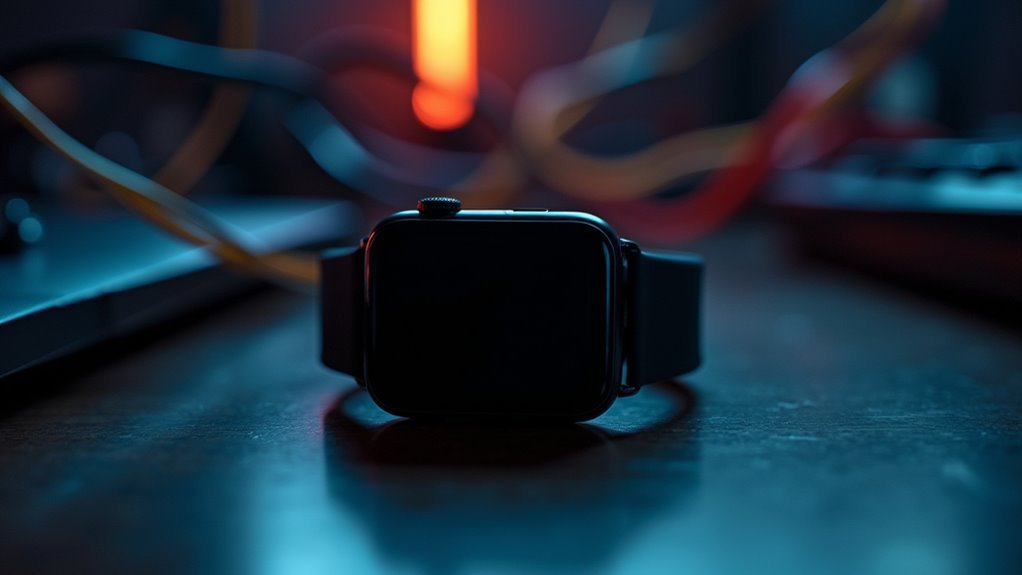
Your voice assistant’s AI algorithms demand significant processing power to understand speech, process natural language, and execute machine learning models in real-time.
These complex computations create substantial computational overhead that drains your device’s battery faster than simpler background tasks. Wearable devices face particular computational limitations when running AI-powered applications due to their compact form factor and battery constraints.
The more sophisticated the AI features you’re using, the harder your processor works and the quicker your battery depletes.
Processing Power Requirements
When your voice assistant processes commands, the underlying AI algorithms demand considerable computational resources that directly impact your device’s battery life.
Your wearable’s microcontroller unit operates with severely restricted processing power compared to smartphones or cloud servers. Memory limitations prevent deployment of complex transformer models like BERT or GPT, which require extensive computational power.
Instead, your device relies on lightweight CNN and RNN models that balance accuracy with energy constraints.
When you trigger voice commands, your wearable activates more hardware components, consuming considerably more power than ultra-low-power wake-word detection. The trade-off is clear: higher accuracy demands more processing, which shortens your battery runtime.
Specialized neural processing units in newer MCUs help, but power limits remain a fundamental constraint. Modern solutions utilize tiny DSPs specifically designed for embedded voice processing to minimize computational overhead while maintaining acceptable performance levels.
Real-Time Algorithm Execution
Real-time algorithm execution creates a computational bottleneck that’s more severe than initial voice processing because your wearable must continuously analyze incoming audio data while maintaining responsiveness.
Your device’s limited processing power struggles with complex machine learning models that perform pattern recognition and data filtering simultaneously. This computational load intensifies when multi-modal systems integrate various sensors, requiring intricate algorithms for cognitive workload monitoring and activity recognition.
Your wearable’s RAM optimization becomes critical as multi-batch processing attempts to reduce memory usage while maintaining real-time performance. The process involves continuous feedback loops that help maintain system responsiveness but further strain the device’s already limited resources.
Edge computing helps by processing data locally, reducing latency, but your device still faces energy efficiency challenges. The continuous cycle of filtering raw data, recognizing patterns, and generating actionable insights demands processing resources that directly impact your battery life through increased power consumption.
Machine Learning Overhead
Beyond the immediate processing demands, machine learning algorithms create a cascading effect on your wearable’s power consumption through their inherent computational complexity.
When your device runs voice recognition models, it’s executing deep learning networks that demand substantial processing power. These AI algorithms don’t just process once—they continuously analyze audio patterns, predict words, and refine accuracy in real-time.
Your wearable’s limited battery capacity makes this computational load particularly challenging. Each layer of neural network processing consumes energy, and complex models require exponentially more power than simple operations.
The data processing overhead strains your device’s resources, forcing processors to work harder and drain battery faster. AI can analyze usage patterns to optimize power allocation, but this analysis itself requires additional computational resources that further impact battery performance. Energy-efficient algorithm design becomes essential, as optimization techniques can notably reduce this machine learning overhead while maintaining voice assistant functionality.
Hardware Limitations in Miniaturized Devices
As voice assistants squeeze into increasingly smaller devices, hardware engineers face a brutal reality: physics doesn’t bend to accommodate consumer demands for sleeker gadgets. Your wearable’s miniaturized battery simply can’t store enough energy to power voice processing demands, forcing frequent charging cycles that disrupt daily use.
Cramming sensors, processors, and radios into tiny spaces creates a perfect storm of inefficiency.
You’re dealing with 8-24 layer PCBs that generate signal crosstalk, parasitic capacitances that leak power, and thermal management nightmares in spaces too small for proper heat dissipation.
The components themselves become less robust as they shrink.
Environmental factors like moisture and vibration hit harder, while manufacturing defects hide easier but cause bigger problems in your pocket-sized device. Modern assemblies rely on customized processes to achieve the precise component placement needed for these ultra-compact voice processing circuits.
Software Architecture Inefficiencies in Legacy Systems
While hardware constraints create obvious power drains, the software running your voice assistant often harbors deeper inefficiencies that silently demolish battery life.
Legacy systems in your wearable devices typically feature monolithic architectures that weren’t designed for AI integration. This creates resource-intensive operations that constantly drain power as your device struggles with outdated protocols and bloated code.
You’ll experience increased latency and reduced accuracy because these systems can’t efficiently process voice commands. The complex integration often triggers repeated communication attempts when errors occur, multiplying battery consumption.
Legacy software lacks optimization for mobile architectures, forcing your device to work harder than necessary. Modern wearables must be optimized for low latency and energy efficiency to prevent excessive power drain. These inefficiencies compound, creating a cascade of power drain that modern microservices architectures and cloud-based solutions could eliminate.
Quantifying Battery Drain: Active Vs Idle Usage Statistics
You’ll find that voice assistants drain your battery differently depending on whether you’re actively using them or they’re running in the background.
Active voice commands can consume 1-5% of your battery per query, while idle assistant processes steadily drain 5-10% daily even without interaction.
These drain rates vary greatly across different smartwatch brands and models, with some devices showing up to 20% battery loss over a typical day when voice features remain enabled. The current architecture requires immediate conversion of analog sound to digital signals, which contributes significantly to this battery consumption.
Active Usage Drain Rates
When your voice assistant springs into action, battery consumption doubles compared to its idle state.
Active voice assistant usage drains approximately 8% of your battery per hour, while passive listening consumes around 4% hourly. This dramatic increase stems from intensive real-time data processing required during voice interactions.
Long conversations with your assistant demand continuous CPU operation and network activity, considerably escalating power draw.
Your device’s microphone, processor, and wireless radios work overtime to capture audio, process commands, and transmit data to cloud servers for analysis.
The frequency of your voice commands directly correlates with battery drain intensity. Voice assistants require constant connectivity for streaming services and real-time updates, which further drains battery resources over time.
Each “Hey Google” activation triggers background processing that persists beyond your actual interaction, creating sustained power consumption that noticeably shortens your device’s daily battery life.
Idle Mode Consumption
Beyond active interactions, your voice assistant continues consuming battery power even when your device appears completely inactive. The “Hey Google” or “Hey Siri” detection keeps your microphone continuously active, listening for wake words and draining battery throughout idle periods.
This constant listening prevents your device from entering deep sleep states, maintaining network connections for potential voice commands. Samsung devices running One UI are particularly susceptible to wakelock issues that keep the system partially awake even when voice assistants are disabled.
Background activities compound the problem. Your assistant stays connected to location and data services, performs real-time processing, and handles syncing updates. These processes can result in considerable battery loss—up to 40% overnight in some cases.
You can notably reduce this drain by disabling always-on listening features, using manual activation instead, enabling battery optimization in your device settings, and turning off unnecessary network connections when possible.
Device Comparison Metrics
Understanding real battery consumption requires precise measurements that distinguish between your device’s different operational states.
Voice assistants typically drain 8% of your battery per hour during active use compared to 4% per hour in idle mode. You’ll notice wearables often show similar or higher consumption rates due to smaller batteries and continuous sensor monitoring.
Your device’s brand and OS version greatly impact these metrics. Motorola and Sony smartwatches demonstrate improved discharge rates over time through firmware updates.
Battery lifecycle effects also play a role—some devices actually become more efficient as manufacturers refine their software. Current voice processing architecture wastes 80% to 90% of battery life by converting and processing irrelevant environmental sounds.
Key measurement factors include percentage consumed, time spent in each state, and comparative analysis between different device configurations and usage patterns.
Device Variations and Brand Performance Differences
Although voice assistants share similar core functionality across devices, the hardware and software choices made by different manufacturers create considerable variations in battery consumption patterns.
You’ll find that different brands implement wake word detection and always-on listening features with varying degrees of efficiency, directly affecting your device’s power draw.
The key factors creating these performance differences include:
- Microphone technology – analog wake microphones consume under 1mW while remaining continuously active
- Audio processor capabilities – advanced processors require ~1MB memory for pre-roll capture, increasing energy demands
- Software optimization – Google Assistant, Siri, and Alexa each have distinct architectures affecting power consumption
- Wireless protocol implementation – BLE and Zigbee efficiency varies considerably between manufacturers
Your device’s active state can consume roughly double the battery compared to passive states. Voice communication systems using low-power microcontrollers can significantly reduce overall power consumption in wearable devices while maintaining acceptable performance levels.
User Behavior Impact on Power Consumption Patterns
While hardware and software implementations create the foundation for battery consumption differences, your actual usage patterns determine how much power your voice assistant truly consumes.
Frequent interactions greatly increase power draw, especially during prolonged sessions requiring cloud connectivity. Multiple wake word activations within short intervals raise energy expenditure considerably.
Repeated wake word triggers and extended cloud-connected sessions dramatically spike your voice assistant’s power consumption within minutes.
Complex, multi-step commands engage more processing resources than simple requests, extending active consumption periods.
When you use voice assistants in noisy environments, false wake detections trigger unnecessary processing cycles. Your speech patterns, including accents or volume variations, can affect recognition accuracy and prompt repeated processing attempts.
Evening usage sessions keep devices powered longer, while fitness tracking or notification requests activate additional sensors, amplifying overall battery drain through sustained wireless activity. Advanced intelligent power management systems can help optimize energy consumption during these demanding multi-sensor operations.
Manual Activation Vs Continuous Voice Detection Trade-Offs
Since your device must choose between constant listening and on-demand activation, you’re facing a fundamental trade-off that directly impacts both convenience and battery performance.
Manual activation cuts your power consumption in half compared to continuous voice detection, but you’ll sacrifice the hands-free experience.
Here’s what continuous voice detection costs you:
- Always-on microphones that drain power even when idle
- Constant audio processing that doubles your battery consumption
- False wake triggers in noisy environments that waste energy
- Pre-roll audio buffering that increases data processing overhead
Your wearable’s battery life depends heavily on this choice.
While manual activation requires button presses, it eliminates unnecessary processing and extends usage time considerably through reduced energy draw. However, many users find that reliability concerns ultimately outweigh the convenience benefits, especially when voice assistants fail to perform consistently in critical situations.
Emerging Low-Power Processor Technologies
The processor industry has responded to these power management challenges with breakthrough technologies that slash energy consumption without compromising performance. You’ll find ultra-low-power microcontrollers (ULP MCUs) at the heart of modern wearables, enabling compact designs with extended battery life. These processors leverage advanced semiconductor materials and optimized architectures that minimize power usage while maintaining functionality.
Edge computing capabilities now allow your device to process voice commands locally, reducing cloud communication and conserving energy. AI integration enhances this efficiency by enabling real-time processing without network dependence. The development of low-power electronics represents a significant market trend driving innovation in wearable technology solutions.
| Technology | Power Benefit | Application |
|---|---|---|
| ULP MCUs | 90% less consumption | Voice processing |
| Edge AI | Reduced cloud calls | Local commands |
| Advanced materials | Enhanced efficiency | Chip manufacturing |
| Optimized architecture | Maintained performance | Real-time monitoring |
AI-Driven Battery Optimization Solutions
As voice assistants become more sophisticated, artificial intelligence revolutionizes how your devices manage battery consumption through predictive algorithms and real-time optimization.
AI analyzes your usage patterns to predict when you’ll use voice commands, adjusting power allocation accordingly. These systems identify which voice processing tasks consume the most energy, enabling targeted optimization strategies.
Smart charging algorithms minimize battery degradation while maintaining quick charging capabilities. AI monitors temperature conditions during voice assistant operations, preventing overheating that damages battery health. Advanced microbattery technology enables slimmer wearable designs without compromising performance or voice assistant functionality.
Key AI-driven optimizations include:
- Dynamic power allocation based on voice command frequency
- Predictive maintenance alerts for battery replacement timing
- Application-specific control prioritizing voice assistant functions
- Real-time monitoring of power consumption patterns
These intelligent solutions extend your wearable’s battery life considerably.
Future Innovations Mimicking Biological Energy Efficiency
While AI optimization maximizes existing battery technology, breakthrough innovations draw inspiration from nature’s most efficient energy systems to power tomorrow’s voice-enabled wearables.
You’ll soon wear devices powered by biofuel cells that harness your sweat’s lactate, converting bodily substances into sustainable electricity. Thermoelectric technologies will capture your body heat, creating constant power without battery replacements.
| Energy Source | Technology | Application |
|---|---|---|
| Sweat | Biofuel Cells | Fitness trackers |
| Body Heat | Thermoelectric | Smartwatches |
| Muscle Activity | Conductive Threads | Smart clothing |
These innovations use flexible, self-healing materials that adapt to your movements while generating power. A wearable microgrid integrating multiple harvesting technologies creates a unified energy ecosystem that maximizes power generation from every available source. Hybrid energy systems combine multiple harvesting methods, ensuring reliable power supply for voice assistants. You’ll experience extended device usage through muscle stimulation technologies that simultaneously generate energy and enhance performance, revolutionizing wearable sustainability.
Frequently Asked Questions
Can I Completely Disable Voice Assistants to Maximize My Wearable’s Battery Life?
Yes, you can completely disable voice assistants on most wearables through device settings. This’ll greatly improve battery life by eliminating constant listening, background processes, and connectivity requirements that drain power.
Which Wearable Brands Offer the Longest Battery Life With Voice Assistants Enabled?
You’ll find Garmin Venu 3 and Amazfit Balance offer the longest battery life with voice assistants, lasting over one week. TicWatch Pro 5 and Samsung Galaxy Watch provide solid middle-ground options.
How Much Battery Life Can I Save by Switching to Manual Activation?
You’ll save significant battery life by switching to manual activation. Disabling always-on voice features can reduce consumption by up to 45% on some devices, extending your wearable’s daily usage considerably.
Do Voice Assistants Drain Battery Faster During Workouts or Physical Activities?
Voice assistants don’t necessarily drain battery faster during workouts themselves. However, you’ll likely use your wearable more frequently during physical activities, leading to increased voice assistant interactions and higher overall battery consumption.
Will Future Wearables Eliminate Voice Assistant Battery Drain Issues Completely?
You’ll likely see significant improvements in future wearables through edge computing, AI optimization, and energy harvesting technologies, but complete elimination of voice assistant battery drain isn’t guaranteed yet.
In Summary
You’ll notice voice assistants greatly impact your wearable’s battery because they’re constantly listening, processing data, and maintaining network connections. The AI algorithms running background operations demand substantial computational power that your device’s small battery can’t sustain long-term. While you can switch to manual activation to conserve energy, emerging low-power processors and AI-driven optimization solutions promise better efficiency. Future innovations mimicking biological systems will likely solve these power consumption challenges completely.

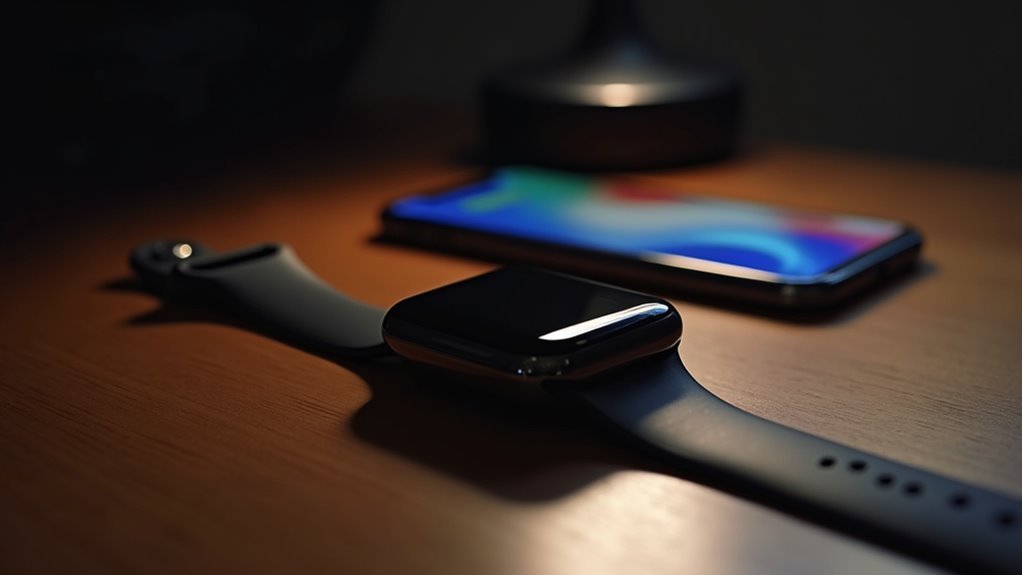

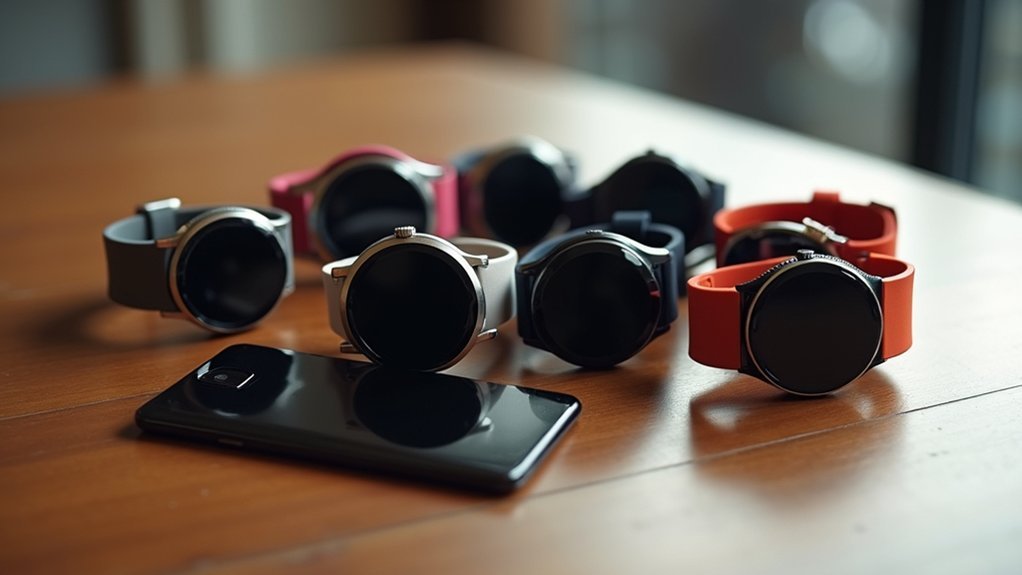
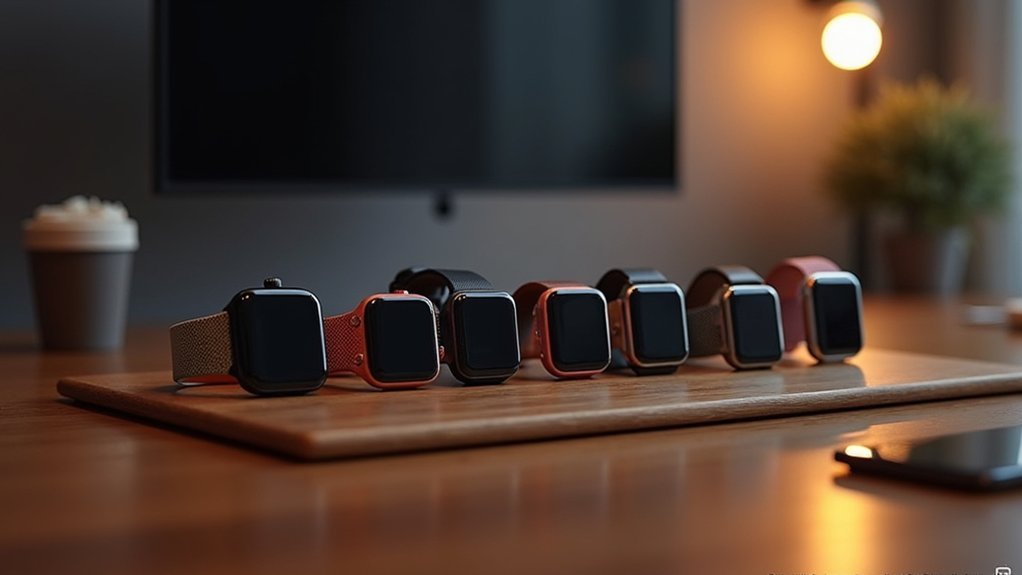
Leave a Reply